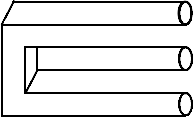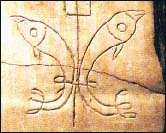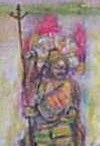Trident Cross
By Paul Harding, with thanks to
Sean Wright for his inspiration, and
Alexander Roman for his updates and corrections
Perhaps the closest we can get to a real Trident Cross is based on the Tryzub. This is an ancient Ukrainian symbol with a fascinating history. (See Tryzub Cross)
A trident is also the main feature on the flag of Barbados. It's not a cross; it's not even intended to be a religious symbol.
As an island nation, the Barbadian trident might be associated with the symbol of Neptune, the Roman god of the sea. But in fact it's the top part of Britannia's trident, snapped off from the shaft, representing the country's independence from Britain in 1966. The barbed tines are appropriate for a country named Barbados. (See Barbed Cross)
to enlarge)
Another religious Trident Cross is the Double Vajra. This is a symbolic weapon commonly seen in Asian art, wielded by gods of dharmic religions such as Buddhism (in various forms), Jainism (the symbol or mark of Dharmanatha) and Hinduism (the weapon of the Vedic god Indra). The word vajra is Sanskrit for 'thunderbolt'.

Trident
Apart from the Tryzub, the Trident Cross is rarely seen in Christian art, for reasons we explain below. The one shown on the left is similar to the Fleur-de-Lis Cross and has strong emphasis on 'three'. Three arms, each with three sharp points, and the meaning is clearly Trinitarian.
&# 128305;
Ψ
&# 936;
(The symbols on the left, if shown, are generated by your browser. The upper symbol is the Unicode character for the trident and the lower one is the Greek letter psi (both magnified 200%). As with other symbols, such as the asterisk, their appearances may vary, depending on your browser. You can recreate this symbols in Microsoft Windows with Alt+1F531 and ALT+936 respectively.)
The Cross and Crown on the left is part of the logo of the United Church of Christ and is quite similar to the trident.
Some claim the trident is (or was) a Pagan symbol and this may be so.
The word 'Trident' is used in many contexts including, for example, the controversial submarine-launched Trident ballistic missile. Lockheed chose the name 'Trident' in 1979 for its WMD, a name which mocks the 1958 symbol of the Campaign for Nuclear Disarmament - a trident in a non-fighting downward orientation (see Broken Cross).
Several battle ships have been named 'Trident', as have cars, record labels, chewing gum and various other company products; there is no patent protection on the name 'Trident'.
Tridents are seen in art depicting mythical gods of the sea.
The symbol on the left is associated with the planet Neptune, named after the Roman god of the sea. This god likes fishing but whilst there's lots of icy water on Neptune, as far as we know there are no fish. Nor worms. But at least he's got his trident ready, and presumably lots of patience.
As well as a fishing spear, the trident was also a gladiator's weapon in Ancient Rome.
The trident is occasionally seen in Christian art, and reconciling this warrior symbol with the love of Christ causes confusion.
The Roman goddess Britannia, often shown with a trident, was adopted by Great Britain and now seen in several churches of national importance. The statue shown on the right is outside St. Paul's Cathedral, London.
(Some are keen to point out the similarity between the trident and the pitchfork carried by the Devil. This is misleading because the trident and the pitchfork are two completely different implements. In any case, it's most unlikely that the Devil carries a pitchfork, or trident; it would just melt in hell's fire.

'Devil's Fork', an impossible structure also known as the 'Devil's Tuning Fork', a 'Blivet' or a 'Poiuyt'.
The origin of the Devil's pitchfork is uncertain. There are similarities with the trident, in that the fork is usually seen with three tines. But rather than a fishing implement or fighting weapon, the Devil's pitchfork is more likely to be an oversized toasting iron - too big for a slice of bread but big enough to roast a sinner over the flames of Hell.
Theological tradition states that the Devil is a spiritual personification of evil; the most evil of spirits and with that definition, a pitchfork makes no difference.
The symbolism of the trident may have had 'dark' symbolism in older religions but in a Christian context, it reflects the teaching of Jesus to his disciples to be "fishers of men". And there is nothing 'dark' or demonic about that.

Before Constantine, Christians tended to conceal their religious identity for fear of persecution. They revealed themselves to each other through symbols such as the fish, the dolphin, the anchor and later, the trident; hence the alternative name; Disguised Cross.
It is not a common Christian symbol today because the meaning is neither clear nor convincing. Here are four interpretations:
| i. | To overcome evil, a military weapon like the fitched St. James Cross |  |
ii. |
When the trident's teeth are short, the trident looks like a crown. Christians refer to Jesus Christ as the King, and when crucified He wore a crown of thorns |
 |
iii. |
When the teeth are long and wavy, they look like flames. Fire is a common way to show the grace of God and also Glory |
 |
iv. |
As a fish-catcher for "fishers of men". |
 |
The problem with the first interpretation (i) is that it's not the most effective weapon to have in an arsenal.
The second interpretation (ii) is plausible but something that looks more like a crown of gold or a crown of thorns is more recognisable. Similarly with the third interpretation (iii), a halo is a more standard art form.
The problem with the fourth (iv) is that tridents do a lot of damage to a fish. Poke a trident into a fish and ask if it likes being saved. (Mental Health Warning: Don't talk to fish.) There'll be no response because the fish will either be dead or writhing in agony. Even hardline fundamentalists and evangelical hermeneuticists will agree that "fishing for men" is a metaphor.
There's one more interpretation:
| v. | Just as the three teeth of the Hindu Shiva trident represent the three-in-one world, the three in a Christian context represent the Holy Trinity |
And here's a further nautical connection:
The mammal famed for saving men is the dolphin. If a dolphin is seen riding the wake of a ship that is considered a good omen for a safe and successful voyage.
It comes as no surprise therefore that Jesus Christ has been depicted in Christian art as a dolphin; the friend and preserver of man. In the Catacomb of Callixtus, is a fresco representing a dolphin twisted around a trident. Another shows the dolphin impaled on a trident to form a Tau Cross. These are interpreted as symbolic of the Crucifixion of Christ. (See also Dolphin Cross)
Shown on the left is an Anchor Cross seen in Provence Gardian in south-eastern France, which Sean Wright identifies as "a symbol of the Three Theological Virtues: Faith, Hope and Love (cross, anchor, heart)." Tridents can be seen at the top and arm ends, made from crescent shaped fleuries.
The three cross arms each with three points are clear and strong references to those three virtues, and of course, the Holy Trinity. Sean goes on to point out another three-three and dolphin in the Old Testament story of the prophet Jonah:
"The dolphin, known by the ancients as a friendly 'fish', was used by the Early Church as a symbol of Christ carrying the souls of Christians to the safety of heaven, as well as a symbol of Jonah and the 'great fish' and therefore a symbol of the Resurrection, since Jesus compared it to Jonah being in the belly of the 'fish' for three days and three nights."
The trident was probably a Pagan symbol before Christians adopted it, just as the cross was.
See also St. James Cross and the Arms of Christ. Fighting swords are seen in Christian art, just as they have been depicted in art for thousands of years before Christ in the late Bronze Age.
Do fish feel pain?
Well don't bother asking animal-rights activists; they'll just slap you with "Of course!", without giving any proof.
And don't bother asking a recreational fishing enthusiasts, who assuage their own guilt at hurting a sentient being by quoting René Descartes who argued that fish lack the brain complexity to feel pain. Or alternatively reply that they don't care one way or the other since they are too preoccupied with the thrill of the sport.
Instead ask scientists, and specifically ichthyologists, who have been convinced through controlled studies of physical and behavioural reactions that fish, if they could speak, would say "Ouch!" quite loudly.
It's true that fish are not the most intelligent beings, and yet they do seem to have the brain complexity to recognize that a bigger fish is a potential danger. They even have the brain complexity to recognize that an even bigger rock is no threat at all. Fish are not so daft.
Human or fish, whatever the level of intelligence or brain complexity, it's pretty obvious that pain exists as a natural physiological response to a threatening situation for any living creature. Do fish feel pain in the same way as humans feel pain? Probably not, and why should they; they are fish, not human. So yes, fish do feel pain.
Source: Christian Epigraphy by Prof. Orazio Marucchi, Professor of Christian Archaeology, Royal University of Rome













